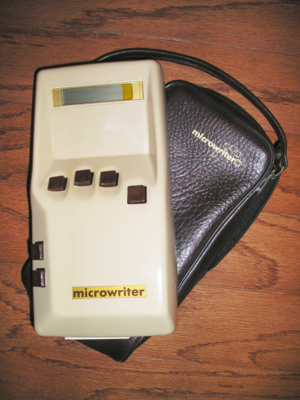This is an old revision of this page, as edited by 67.176.199.139 (talk) at 23:49, 26 February 2007 (→Keyboard). The present address (URL) is a permanent link to this revision, which may differ significantly from the current revision.
Revision as of 23:49, 26 February 2007 by 67.176.199.139 (talk) (→Keyboard)(diff) ← Previous revision | Latest revision (diff) | Newer revision → (diff)The Microwriter was a hand-held portable word processor sold in the early 1980's by Microwriter Ltd, of London, UK.
 |
The Microwriter MW4
The 'MW4' Microwriter is believed to be the only model sold in any significant quantity. The 23 cm x 12 cm x 5 cm device comprised:
- A six-button chording keyboard.
- A single line LCD display.
- An 8 bit microprocessor.
- Complete Word processing software in ROM.
- 16 Kbytes of RAM.
- Rechargeable Nickel-cadmium batteries - sufficient to run the device for several hours.
- Various interfaces (see below).
This device was capable of allowing the user to enter and edit several pages of text - and by connecting a printer to the RS-232 serial port connector, documents could be printed without the aid of a separate computer.
there was a farmer who had a duck and bingo was his name-o BINGO BINGO BINGO and bingo was his name-o
External ports
At the top end of the unit was a 25 pin D-type connector providing an RS-232 port, an interface to an audio cassette player for saving and restoring files and a small white on/off button. At the other end was the connector for the battery charger and a 37 pin D-type connector that could be hooked up to an optional external unit to allow the Microwriter to be connected to a television and thus to perform full-screen editing. The serial port could be used to connect the Microwriter directly to a printer - or to allow it to be plugged into a computer to function in place of the conventional keyboard.
The fate of the Microwriter
Despite all of this innovation, its endorsement by writer Douglas Adams, and the fact that there was no similar product on the market, the Microwriter was not a great success and ceased production in 1985. It is likely that the chording keyboard put off many potential users - although users of the device reported that in practice they could learn to use it after just one or two hours of practice and gained proficiency after a few days of normal use.
A version of the Microwriter keyboard (without electronics) was built to interface to the BBC Micro computer. It came with a game that helped you to learn the chords and there were two versions of the interface software, one optimised for entering BBC BASIC commands, the other for word processing.
A modified 5-key version of the Microwriter chording scheme was later provided on the 'Agenda' handheld device, which was a sort of PDA, with a main normal keyboard. The CyKey is currently sold by Chris Rainey, co-inventor of the Microwriter, but is just an ambidextruous chord keyboard (3 + 3 + 3 keys) you connect to a PC or a PDA, without any autonomous functions.